Page 557 of 613
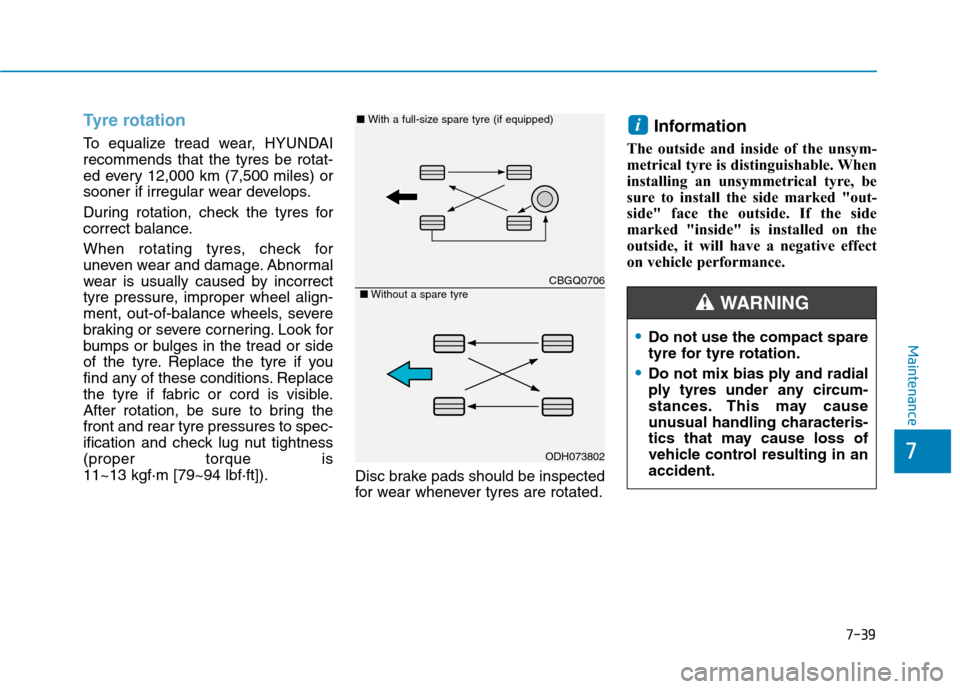
7-39
7
Maintenance
Tyre rotation
To equalize tread wear, HYUNDAI
recommends that the tyres be rotat-
ed every 12,000 km (7,500 miles) or
sooner if irregular wear develops.
During rotation, check the tyres for
correct balance.
When rotating tyres, check for
uneven wear and damage. Abnormal
wear is usually caused by incorrect
tyre pressure, improper wheel align-
ment, out-of-balance wheels, severe
braking or severe cornering. Look for
bumps or bulges in the tread or side
of the tyre. Replace the tyre if you
find any of these conditions. Replace
the tyre if fabric or cord is visible.
After rotation, be sure to bring the
front and rear tyre pressures to spec-
ification and check lug nut tightness
(proper torque is
11~13 kgf·m [79~94 lbf·ft]).
Disc brake pads should be inspected
for wear whenever tyres are rotated.
Information
The outside and inside of the unsym-
metrical tyre is distinguishable. When
installing an unsymmetrical tyre, be
sure to install the side marked "out-
side" face the outside. If the side
marked "inside" is installed on the
outside, it will have a negative effect
on vehicle performance.
i
CBGQ0706
ODH073802
■ With a full-size spare tyre (if equipped)
■Without a spare tyre
Do not use the compact spare
tyre for tyre rotation.
Do not mix bias ply and radial
ply tyres under any circum-
stances. This may cause
unusual handling characteris-
tics that may cause loss of
vehicle control resulting in an
accident.
WARNING
Page 562 of 613
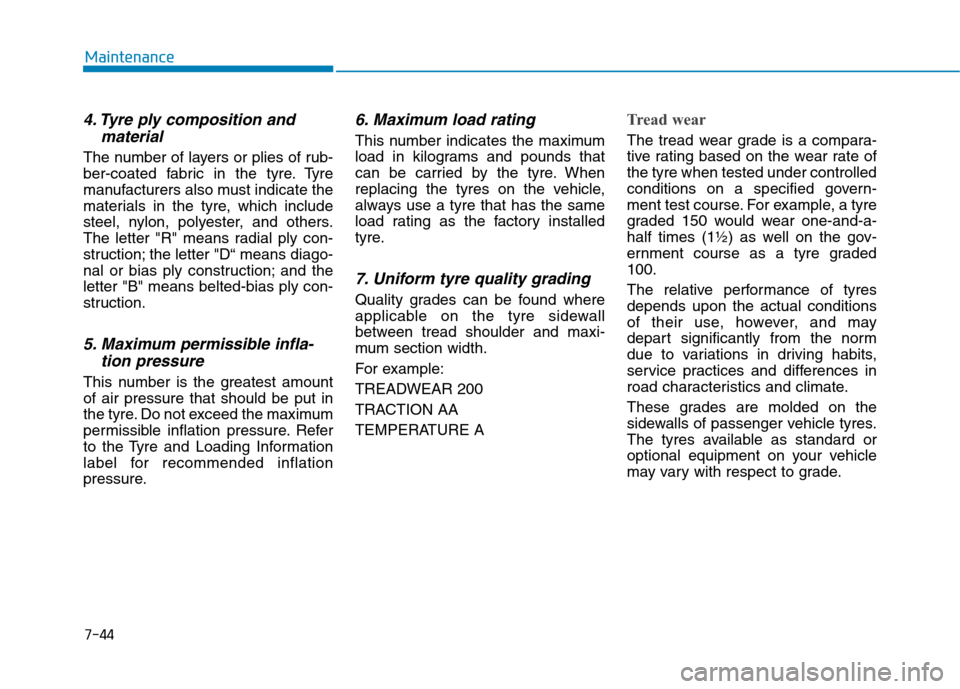
7-44
Maintenance
4. Tyre ply composition and
material
The number of layers or plies of rub-
ber-coated fabric in the tyre. Tyre
manufacturers also must indicate the
materials in the tyre, which include
steel, nylon, polyester, and others.
The letter "R" means radial ply con-
struction; the letter "D“ means diago-
nal or bias ply construction; and the
letter "B" means belted-bias ply con-
struction.
5. Maximum permissible infla-
tion pressure
This number is the greatest amount
of air pressure that should be put in
the tyre. Do not exceed the maximum
permissible inflation pressure. Refer
to the Tyre and Loading Information
label for recommended inflation
pressure.
6. Maximum load rating
This number indicates the maximum
load in kilograms and pounds that
can be carried by the tyre. When
replacing the tyres on the vehicle,
always use a tyre that has the same
load rating as the factory installed
tyre.
7. Uniform tyre quality grading
Quality grades can be found where
applicable on the tyre sidewall
between tread shoulder and maxi-
mum section width.
For example:
TREADWEAR 200
TRACTION AA
TEMPERATURE A
Tread wear
The tread wear grade is a compara-
tive rating based on the wear rate of
the tyre when tested under controlled
conditions on a specified govern-
ment test course. For example, a tyre
graded 150 would wear one-and-a-
half times (1½) as well on the gov-
ernment course as a tyre graded
100.
The relative performance of tyres
depends upon the actual conditions
of their use, however, and may
depart significantly from the norm
due to variations in driving habits,
service practices and differences in
road characteristics and climate.
These grades are molded on the
sidewalls of passenger vehicle tyres.
The tyres available as standard or
optional equipment on your vehicle
may vary with respect to grade.
Page 564 of 613
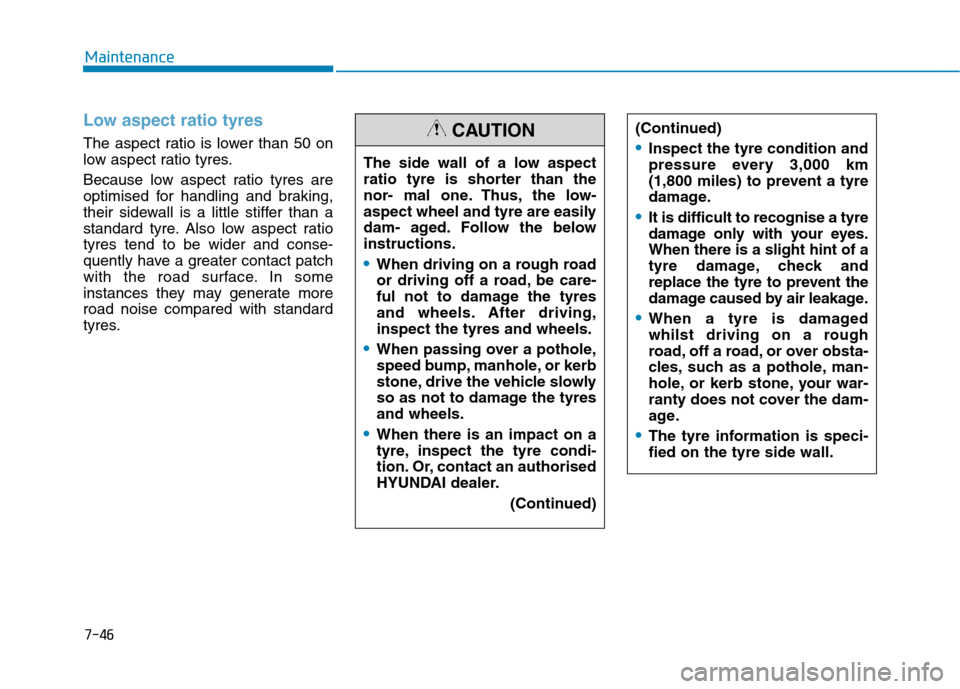
7-46
Maintenance
Low aspect ratio tyres
The aspect ratio is lower than 50 on
low aspect ratio tyres.
Because low aspect ratio tyres are
optimised for handling and braking,
their sidewall is a little stiffer than a
standard tyre. Also low aspect ratio
tyres tend to be wider and conse-
quently have a greater contact patch
with the road surface. In some
instances they may generate more
road noise compared with standard
tyres.The side wall of a low aspect
ratio tyre is shorter than the
nor- mal one. Thus, the low-
aspect wheel and tyre are easily
dam- aged. Follow the below
instructions.
When driving on a rough road
or driving off a road, be care-
ful not to damage the tyres
and wheels. After driving,
inspect the tyres and wheels.
When passing over a pothole,
speed bump, manhole, or kerb
stone, drive the vehicle slowly
so as not to damage the tyres
and wheels.
When there is an impact on a
tyre, inspect the tyre condi-
tion. Or, contact an authorised
HYUNDAI dealer.
(Continued)
CAUTION(Continued)
Inspect the tyre condition and
pressure every 3,000 km
(1,800 miles) to prevent a tyre
damage.
It is difficult to recognise a tyre
damage only with your eyes.
When there is a slight hint of a
tyre damage, check and
replace the tyre to prevent the
damage caused by air leakage.
When a tyre is damaged
whilst driving on a rough
road, off a road, or over obsta-
cles, such as a pothole, man-
hole, or kerb stone, your war-
ranty does not cover the dam-
age.
The tyre information is speci-
fied on the tyre side wall.
Page 604 of 613
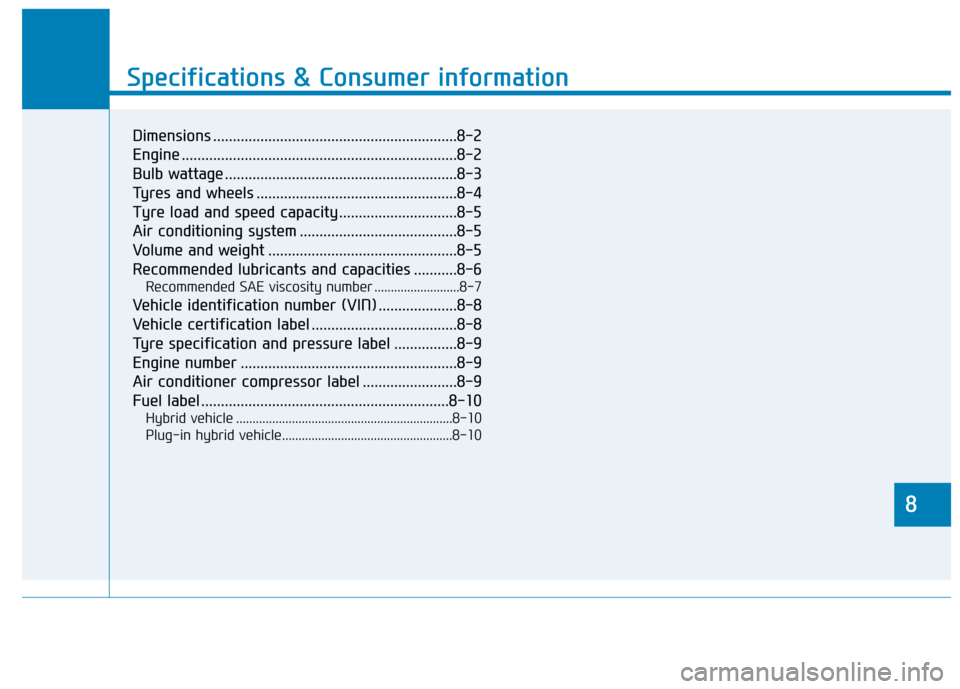
8
Specifications & Consumer information
8
Specifications & Consumer information
8
Dimensions ..............................................................8-2
Engine ......................................................................8-2
Bulb wattage ...........................................................8-3
Tyres and wheels ...................................................8-4
Tyre load and speed capacity ..............................8-5
Air conditioning system ........................................8-5
Volume and weight ................................................8-5
Recommended lubricants and capacities ...........8-6
Recommended SAE viscosity number ..........................8-7
Vehicle identification number (VIN) ....................8-8
Vehicle certification label .....................................8-8
Tyre specification and pressure label ................8-9
Engine number .......................................................8-9
Air conditioner compressor label ........................8-9
Fuel label ...............................................................8-10
Hybrid vehicle ..................................................................8-10
Plug-in hybrid vehicle....................................................8-10
Page 607 of 613
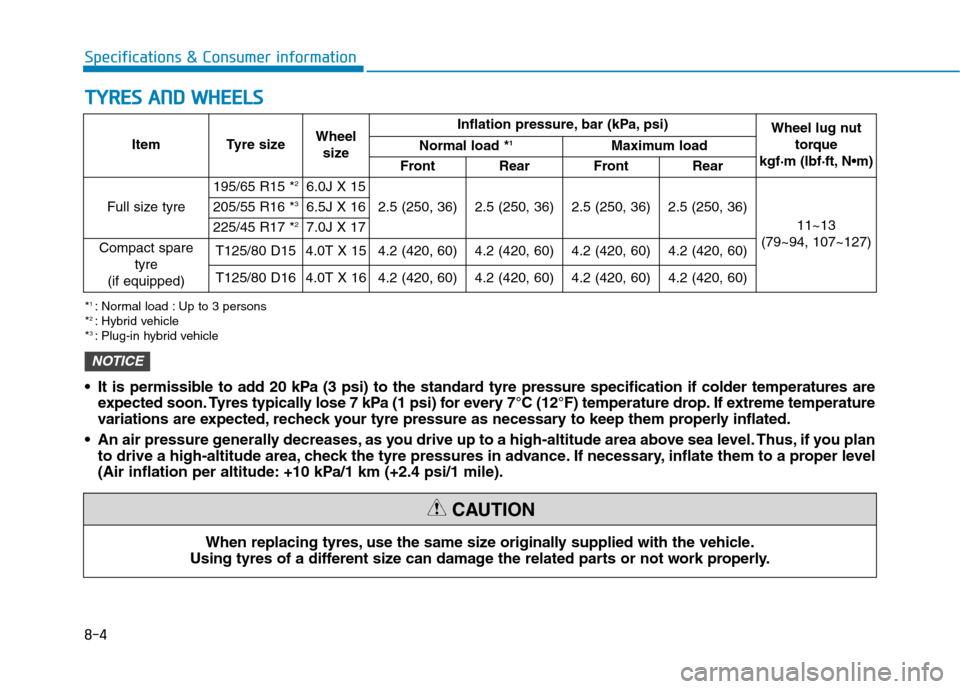
8-4
Specifications & Consumer information
T TY
YR
RE
ES
S
A
AN
ND
D
W
WH
HE
EE
EL
LS
S
Item Tyre sizeWheel
sizeInflation pressure, bar (kPa, psi)
Wheel lug nut
torque
kgf·m (lbf·ft, N Normal load *1Maximum load
Front Rear Front Rear
Full size tyre195/65 R15 *
26.0J X 15
2.5 (250, 36) 2.5 (250, 36) 2.5 (250, 36) 2.5 (250, 36)
11~13
(79~94, 107~127) 205/55 R16 *
36.5J X 16
225/45 R17 *
27.0J X 17
Compact spare
tyre
(if equipped)T125/80 D154.0T X 154.2 (420, 60)4.2 (420, 60)4.2 (420, 60)4.2 (420, 60)
T125/80 D164.0T X 164.2 (420, 60)4.2 (420, 60)4.2 (420, 60)4.2 (420, 60)
When replacing tyres, use the same size originally supplied with the vehicle.
Using tyres of a different size can damage the related parts or not work properly.
CAUTION
*1 : Normal load : Up to 3 persons
*2 : Hybrid vehicle
*3 : Plug-in hybrid vehicle
It is permissible to add 20 kPa (3 psi) to the standard tyre pressure specification if colder temperatures are
expected soon. Tyres typically lose 7 kPa (1 psi) for every 7°C (12°F) temperature drop. If extreme temperature
variations are expected, recheck your tyre pressure as necessary to keep them properly inflated.
An air pressure generally decreases, as you drive up to a high-altitude area above sea level. Thus, if you plan
to drive a high-altitude area, check the tyre pressures in advance. If necessary, inflate them to a proper level
(Air inflation per altitude: +10 kPa/1 km (+2.4 psi/1 mile).
NOTICE